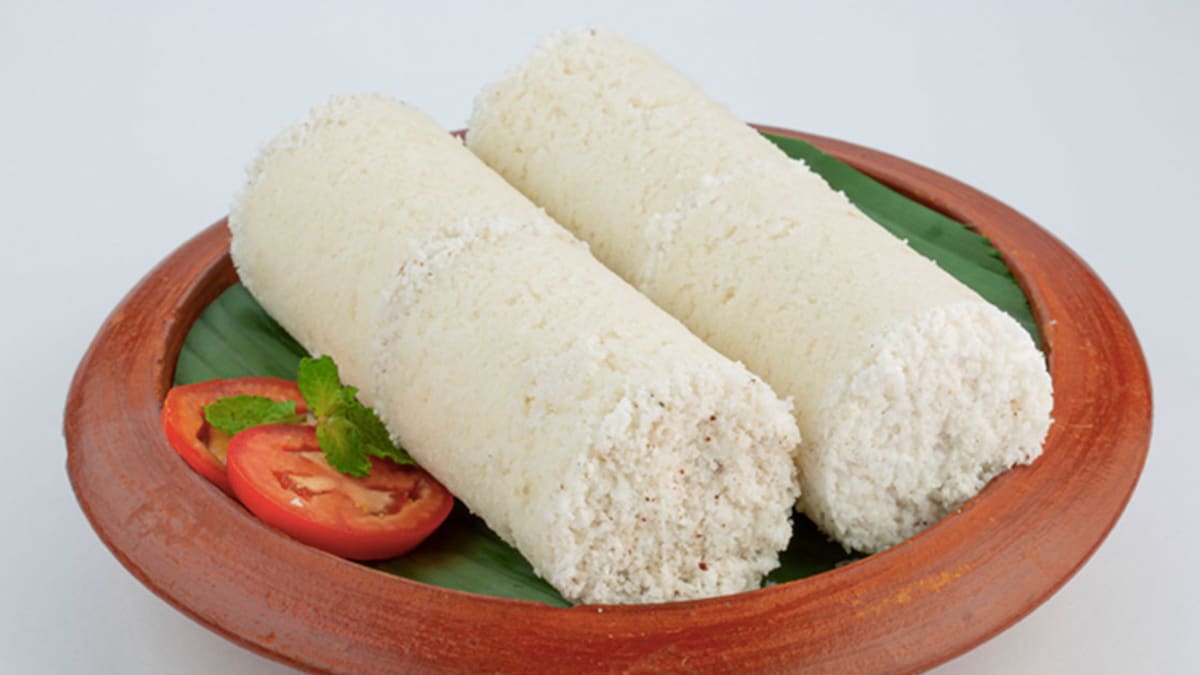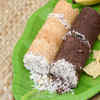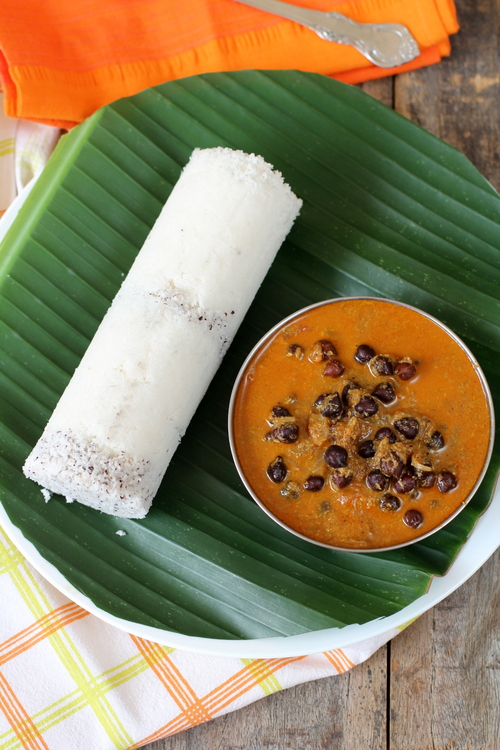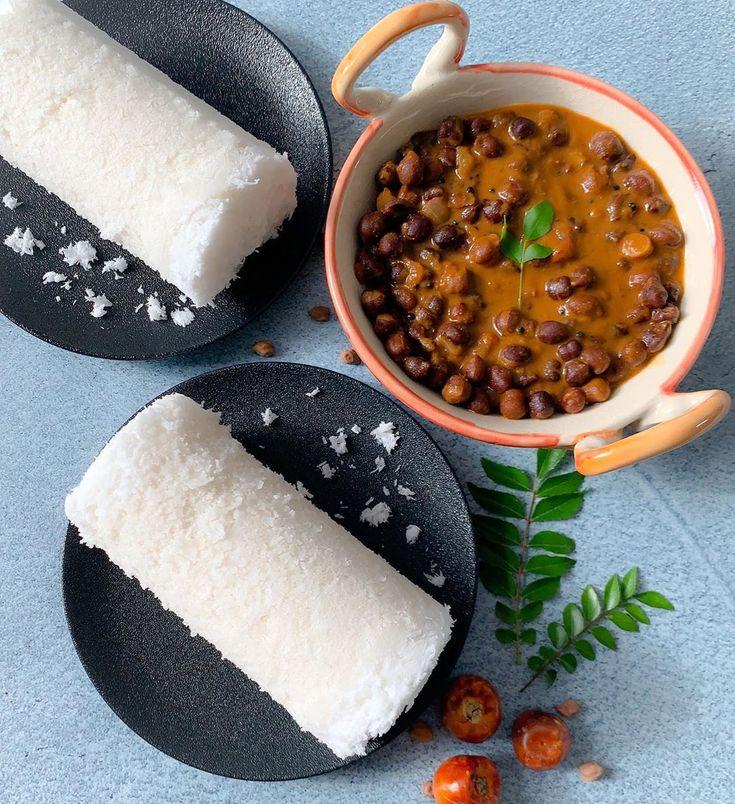Puttu is a cherished breakfast dish hailing from the southern part of India, particularly popular in Kerala and parts of Tamil Nadu. It’s a delectable steamed rice cake, notable for its cylindrical shape and textured layers of grated coconut. The name ‘puttu’ itself translates to ‘portioned’ in Tamil, which elegantly describes how this dish is served—neatly segmented, with each portion exuding the comforting warmth of home cooking.
The inherent beauty of puttu lies in its simplicity and the wholesomeness it imparts. Its base is made from rice flour moistened with water to a crumbly texture and layered with fresh coconut shreds. These ingredients are then carefully packed into a ‘puttu kutti’—a special cylindrical steamer that stands atop a ‘puttu kudam’, or pressure cooker, letting the steam pass through the layers to cook the rice mixture.
Puttu Steamed Rice Cakes Layered with Coconut Recipe


Puttu Steamed Rice Cakes Layered with Coconut
Equipment
- 1 large bowl
- 1 pot
Ingredients
- 1 cup white puttu flour
- 1/4 teaspoon salt
- 1/2 cup water
- 1 cup shredded fresh coconut or frozen, thawed to room temperature
Instructions
- In a large bowl, combine the flour and salt. Slowly add the water to the bowl while using your fingers to mix the flour and water together until it is a cornmeal consistency. The amount of water you need depends on the quality and type of puttu flour you use.
- Fill the bottom pot of the puttu steamer three-quarters full with water and close it. Bring the water to a boil so steam comes from the nozzle.
- Place 2 tablespoons of shredded coconut in the steaming cylinder. Add enough batter to fill one-quarter of the cylinder. Add another 2 tablespoons of coconut, followed by an additional one-quarter-cylinder amount of batter. Close the cylinder and place it on top of the steaming pot. Steam for 4 minutes.
- Remove the cylinder from the pot. Carefully open the lid and remove the puttu. Repeat with the remaining batter and coconut.
Notes
Cooking Tips about Puttu Steamed Rice Cakes Layered with Coconut

- Rice Flour Quality: The key to soft and moist puttu lies in using finely ground rice flour specifically meant for puttu, which is slightly different from regular rice flour due to its coarser texture.
- Moisture Content: The rice flour needs to be moistened with water until it reaches a crumbly consistency. It should be damp but not wet; when pressed in your hand, the flour should hold together but crumble easily when pressed harder.
- Layering with Coconut: Freshly grated coconut is essential for authentic taste and texture. The art of layering the moist rice flour with grated coconut in the cylindrical steamer—known as ‘puttu kutti’—is crucial, as this determines the pattern of soft rice flakes and flavorful coconut layers in the finished product.
- Steamer Preparation: Puttu is traditionally steamed in a bamboo or metal ‘puttu kutti’ which is placed on top of a ‘puttu kudam’ or a pot of boiling water. Ensure a snug fit to prevent steam from escaping.
- Steaming Time: Once the water starts boiling and steam begins to pass through the holes of the ‘puttu kutti’, it’s time to place the filled puttu cylinder on top. Steam for roughly 5 to 7 minutes, or until steam starts coming out through the top of the ‘puttu kutti’, emitting a cooked rice flour aroma.
- Serving: As soon as the puttu is ready, remove from the steamer and serve hot. The traditional companion for puttu is kadala (chickpea) curry, though it pairs wonderfully with bananas, papadums, or even ghee and sugar.
- Consistency Checking: Tap the bottom of the ‘puttu kutti’, and the puttu should slide out easily if the moisture content was right. If the puttu sticks inside, it may need more steaming or indicates that there was too much moisture in the rice flour.
- Flour Storage: If you’re using store-bought puttu flour, make sure to store it in an airtight container to protect it from humidity and keep it fresh.
- Variations: While rice puttu is traditional, variations can include adding different grains like ragi or wheat as part or all of the base for a nutritional twist.
- Experiment with Flavors: You can add spices like cumin or cardamom to the flour for an aromatic flavor, or even incorporate palm sugar with coconut for a sweet version of the dish.
Serving suggestions about Puttu Steamed Rice Cakes Layered with Coconut

- Kadala Curry: The classic companion to puttu is kadala curry—a rich and hearty Kerala-style chickpea curry, flavored with coconut, shallots, mustard seeds, and aromatic spices.
- Bananas: A simple yet popular way to enjoy puttu is with ripe bananas. They can be sliced and mixed with the puttu or eaten separately with each bite for a naturally sweet contrast.
- Pappadam: Crisp, golden pappadams provide a crunchy texture against the softness of puttu, making for a playful and satisfying combo.
- Ghee and Sugar: For those who have a sweet tooth, combining puttu with a sprinkle of sugar and a spoonful of ghee (clarified butter) transforms it into a delightful dessert.
- Stewed Meats: Rich and flavorful stews made with beef, chicken, or lamb complement the light puttu, creating a more indulgent meal suitable for any time of day.
- Coconut Milk: Pouring a bit of sweetened or spiced coconut milk over puttu keeps it moist and adds layers of creamy flavor.
- Fish Curry: Coastal regions often pair puttu with spicy fish curries, which soaks into the rice layers for a zesty and fulfilling meal.
- Vegetable Stew: Mild vegetable stew, often made with coconut milk and aromatic spices, offers a comforting vegetarian option that pairs well with the puttu.
- Grated Coconut: While puttu already contains layers of grated coconut, adding extra freshly grated coconut on top enhances the taste and texture.
Top 5 FAQs about Puttu Steamed Rice Cakes Layered with Coconut

- What makes Puttu different from other steamed cakes? Puttu is unique due to its cylindrical shape, the distinct layers of ground rice and coconut, and its method of preparation using a special steamer called ‘puttu kutti’. It doesn’t involve fermenting, unlike many other rice-based Indian dishes, and has a crumbly texture that binds well when pressed but falls apart gently upon eating.
- Can Puttu be made with ingredients other than rice? Yes, while rice is traditional, Puttu can also be made with other grains like wheat, corn, ragi (finger millet), or a mix of these. Each grain imparts a different flavor and texture to the dish while expanding its nutritional profile.
- How is the rice flour for Puttu prepared? Puttu requires a particular type of rice flour that is slightly coarser than regular rice flour. The rice is washed, dried, and then ground into a coarse powder before being used to make Puttu. This flour is then moistened with water to a crumbly consistency before it is layered with grated coconut and steamed.
- What side dishes complement Puttu the best? Puttu pairs wonderfully with a variety of sides. The most popular accompaniments include kadala curry (chickpea curry), ripe bananas, ghee and sugar, pappadam (crisp lentil crackers), fish curry, and stewed meats. Sweetened or spiced coconut milk can also be poured over the Puttu for added flavor.
- Is Puttu suitable for people with dietary restrictions? Puttu is gluten-free and contains no added fats or oils, making it an excellent option for those who are health-conscious or have dietary restrictions such as gluten intolerance. It’s also easily adaptable for vegan diets by choosing suitable side dishes.
In summing up the essence of Puttu, this cherished food item stands as a testament to the depth and diversity of southern India’s culinary traditions. The steamed rice cakes, layered with coconut, oh-so-gently introduce a symphony of textures and flavors unique to each delicate cylinder. Puttu is not only satisfying to the palate but also nourishing to the body, incorporating the wholesomeness of rice and the richness of coconut without relying on any added fats or oils.

Leave a Reply